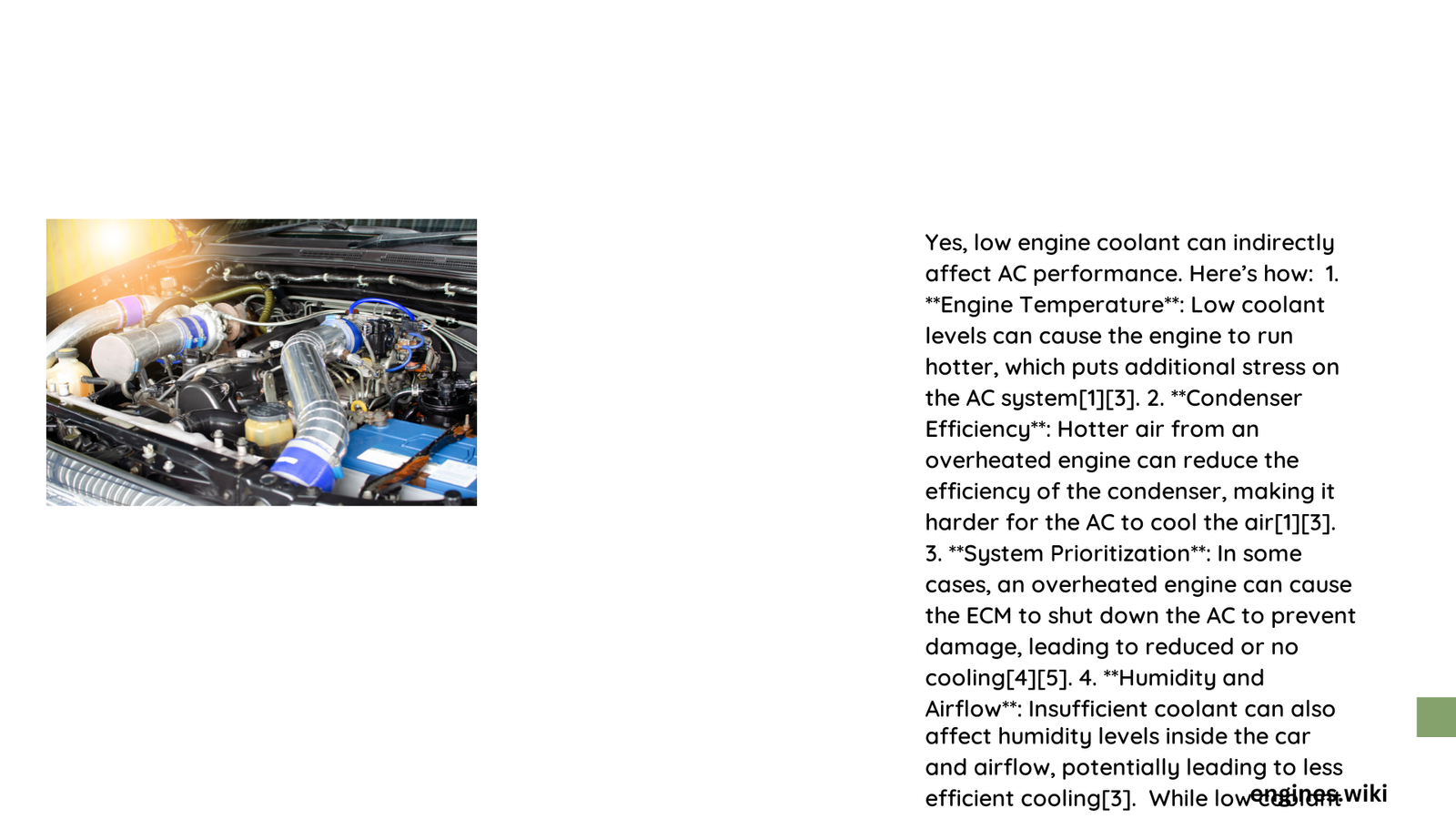Low engine coolant can indirectly compromise your vehicle’s air conditioning system by causing increased engine temperatures, potentially stressing the AC compressor and reducing overall cooling efficiency. While not a direct cause of AC failure, understanding the intricate relationship between coolant levels and air conditioning performance is crucial for maintaining your vehicle’s optimal functionality and preventing costly repairs.\n\n## What Happens When Engine Coolant Levels Drop?\n\nEngine coolant plays a critical role in maintaining proper temperature regulation within your vehicle’s complex mechanical system. When coolant levels decrease, several interconnected mechanisms can impact your air conditioning performance:\n\n### How Does Low Coolant Affect AC System Functionality?\n\n1. Indirect Temperature Impact\n – Increased engine temperature\n – Potential stress on AC compressor\n – Reduced cooling system efficiency\n\n2. Compressor Performance Risks\n – Higher operational temperatures\n – Accelerated mechanical wear\n – Potential premature component failure\n\n### What Are the Specific Symptoms of Coolant-Related AC Issues?\n\n| Symptom | Potential Cause | Recommended Action |\n|———|—————-|——————–|\n| Warm air from vents | Overheating engine | Check coolant levels |\n| Reduced cooling efficiency | Compressor stress | Inspect AC system |\n| Temperature warning lights | Low coolant volume | Immediate system evaluation |\n\n## Critical Factors in Coolant and AC Interaction\n\nVehicle owners must understand that while low engine coolant doesn’t directly disable the AC system, it creates a cascade of potential complications. The intricate relationship between coolant levels and overall vehicle performance demands proactive maintenance.\n\n### What Temperature Ranges Indicate Potential Problems?\n\nTypical operational parameters suggest:\n- Normal engine temperature: 90-100°C (194-212°F)\n- Critical temperature range: 110-120°C (230-248°F)\n- Risk zone: Above 120°C (248°F)\n\n## Diagnostic and Maintenance Strategies\n\nTo prevent potential AC system complications related to coolant levels:\n\n- Regularly check engine coolant levels\n- Inspect cooling system components\n- Monitor engine temperature gauges\n- Schedule routine professional maintenance\n\n### How Much Can Repairs Cost?\n\nPotential repair expenses might include:\n- AC compressor replacement: $500 – $2,000\n- Cooling system component repairs: $200 – $1,500\n\n## Professional Recommendations\n\nWhile low engine coolant can create indirect challenges for your vehicle’s air conditioning system, consistent maintenance remains the most effective prevention strategy. Professional mechanics recommend:\n\n1. Quarterly coolant level inspections\n2. Annual cooling system comprehensive evaluations\n3. Immediate attention to temperature warning indicators\n\n### Key Takeaways\n\n- Low coolant doesn’t directly cause AC failure\n- Indirect temperature-related stress can impact AC performance\n- Regular maintenance prevents potential system complications\n\n## Conclusion\n\nUnderstanding the nuanced relationship between engine coolant and air conditioning functionality empowers vehicle owners to make informed maintenance decisions, ultimately protecting their automotive investment.\n\n### Reference:\n- Brakemax AC System Guide\n- First Tire & Automotive Cooling System Insights\n- Automovill Vehicle Maintenance Resources

